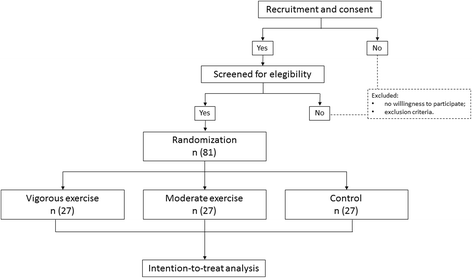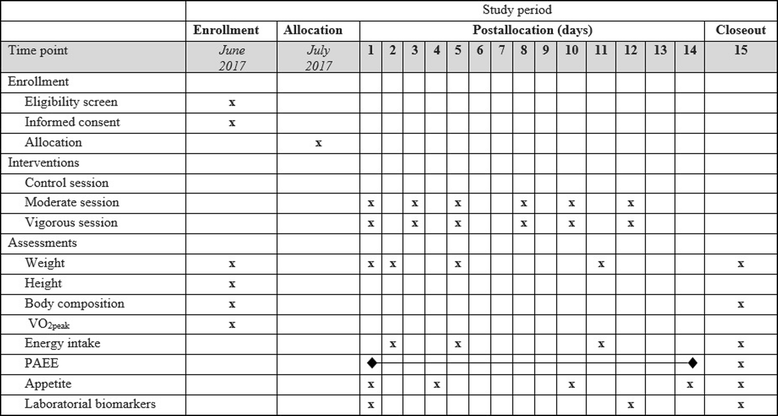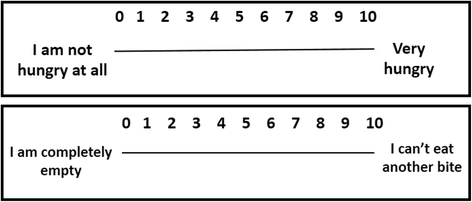Effect of physical exercise on spontaneous physical activity energy expenditure and energy intake in overweight adults (the EFECT study): a study protocol for a randomized controlled trial
- PMID: 29514690
- PMCID: PMC5842658
- DOI: 10.1186/s13063-018-2445-6
Effect of physical exercise on spontaneous physical activity energy expenditure and energy intake in overweight adults (the EFECT study): a study protocol for a randomized controlled trial
Abstract
Background: Physical exercise interventions have been extensively advocated for the treatment of obesity; however, clinical trials evaluating the effectiveness of exercise interventions on weight control show controversial results. Compensatory mechanisms through a decrease in energy expenditure and/or an increase in caloric consumption is a possible explanation. Several physiological mechanisms involved in the energy balance could explain compensatory mechanisms, but the influences of physical exercise on these adjustments are still unclear. Therefore, the present trial aims to evaluate the effects of exercise on non-exercise physical activity energy expenditure, energy intake and appetite sensations among active overweight/obese adults, as well as, to investigate hormonal changes associated with physical exercise.
Methods: This study is a randomized controlled trial with parallel, three-group experimental arms. Eighty-one overweight/obese adults will be randomly allocated (1:1:1 ratio) to a vigorous exercise group, moderate exercise group or control group. The trial will be conducted at a military institution and the intervention groups will be submitted to exercise sessions in the evening, three times a week for 65 min, during a 2-week period. The primary outcome will be total spontaneous physical activity energy expenditure during a 2-week period. Secondary outcomes will be caloric intake, appetite sensations and laboratorial biomarkers. Intention-to-treat analysis will be performed using linear mixed-effects models to evaluate the effect of treatment-by-time interaction on primary and secondary outcomes. Data analysis will be performed using SAS 9.3 and statistical significance will be set at p < 0.05.
Discussion: The results of the present study will help to understand the effect of physical exercise training on subsequent non-exercise physical activity, appetite and energy intake as well as understand the physiological mechanisms underlying a possible compensatory phenomenon, supporting the development of more effective interventions for prevention and treatment of obesity.
Trial registration: Physical Exercise and Energy Balance trial registry, trial registration number: NCT 03138187 . Registered on 30 April 2017.
Trial registration: ClinicalTrials.gov NCT03138187.
Keywords: Compensatory effect; Energy intake; Exercise training; Obesity; Physical activity energy expenditure.
Conflict of interest statement
Ethics approval and consent to participate
The written informed consent will be obtained from all participants before the beginning of the study and all procedures were analyzed and approved by the Research Ethics Committee of the Institute of Social Medicine of the State University of Rio de Janeiro (CAAE: 55667716.6.0000.5260). Any protocol amendments will be submitted to the Research Ethics Committee for approval. Only researchers will have access to participant data that will be kept in a secured office. Dissemination of the trial results will occur through presentations at conferences and publications in scientific journals.
Consent for publication
Not applicable
Competing interests
The authors declare that they have no competing interests.
Publisher’s Note
Springer Nature remains neutral with regard to jurisdictional claims in published maps and institutional affiliations.
Figures
Similar articles
-
Intermittent fasting, energy balance and associated health outcomes in adults: study protocol for a randomised controlled trial.Trials. 2018 Feb 2;19(1):86. doi: 10.1186/s13063-018-2451-8. Trials. 2018. PMID: 29394908 Free PMC article.
-
The 24-h energy intake of obese adolescents is spontaneously reduced after intensive exercise: a randomized controlled trial in calorimetric chambers.PLoS One. 2012;7(1):e29840. doi: 10.1371/journal.pone.0029840. Epub 2012 Jan 17. PLoS One. 2012. PMID: 22272251 Free PMC article. Clinical Trial.
-
Effects of an exercise program on hepatic metabolism, hepatic fat, and cardiovascular health in overweight/obese adolescents from Bogotá, Colombia (the HEPAFIT study): study protocol for a randomized controlled trial.Trials. 2018 Jun 25;19(1):330. doi: 10.1186/s13063-018-2721-5. Trials. 2018. PMID: 29941024 Free PMC article.
-
Acute exercise and subsequent nutritional adaptations: what about obese youths?Sports Med. 2012 Jul 1;42(7):607-13. doi: 10.2165/11632460-000000000-00000. Sports Med. 2012. PMID: 22613045 Review.
-
Appetite control and energy balance: impact of exercise.Obes Rev. 2015 Feb;16 Suppl 1:67-76. doi: 10.1111/obr.12257. Obes Rev. 2015. PMID: 25614205 Review.
Cited by
-
Randomized Controlled Trials to Treat Obesity in Military Populations: A Systematic Review and Meta-Analysis.Nutrients. 2023 Nov 14;15(22):4778. doi: 10.3390/nu15224778. Nutrients. 2023. PMID: 38004172 Free PMC article.
-
Energy Imbalance Gap, Anthropometric Measures, Lifestyle, and Sociodemographic Correlates in Latin American Adults-Results from the ELANS Study.Int J Environ Res Public Health. 2022 Jan 20;19(3):1129. doi: 10.3390/ijerph19031129. Int J Environ Res Public Health. 2022. PMID: 35162152 Free PMC article.
-
Walk or be walked by the dog? The attachment role.BMC Public Health. 2024 Mar 4;24(1):684. doi: 10.1186/s12889-024-18037-4. BMC Public Health. 2024. PMID: 38438977 Free PMC article.
-
The Effects of an Acute Bout of Aerobic or Resistance Exercise on Nonexercise Physical Activity.Exerc Sport Mov. 2023 Spring;1(2):e00004. doi: 10.1249/esm.0000000000000004. Epub 2023 Mar 9. Exerc Sport Mov. 2023. PMID: 37538306 Free PMC article.
References
-
- Ng M, Fleming T, Robinson M, Thomson B, Graetz N, Margono C, et al. Global, regional, and national prevalence of overweight and obesity in children and adults during 1980–2013: a systematic analysis for the Global Burden of Disease Study 2013. Lancet. 2014;384:766–81. doi: 10.1016/S0140-6736(14)60460-8. - DOI - PMC - PubMed
Publication types
MeSH terms
Associated data
LinkOut - more resources
Full Text Sources
Other Literature Sources
Medical
Miscellaneous




